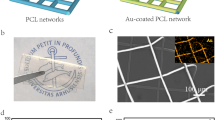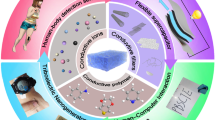Abstract
Soft electronics, which require mechanical elasticity, rely on elastic materials that have both a small Young’s modulus and a large elastic strain range. These materials, however, are prone to damage when stress accumulates, presenting a significant challenge for soft electronics. To address this issue, the integration of self-healing functionality into these materials appears to be a promising solution. Dynamic covalent bond chemistry has been utilized to design high-strength polymers with controllable reversibility. Nonetheless, the temperature needed to trigger self-healing may induce thermal damage to other parts of the device. In contrast, if the self-healing temperature is reduced, the device might suffer damage when exposed to temperatures exceeding the self-healing point due to the low stability of the polymer at high temperatures. These challenges highlight the need for materials that can self-heal at low temperatures while maintaining thermal stability at high temperatures. In response to this challenge, we propose a novel approach that involves forming a microfibrous network using polycaprolactone (PCL), a material with a low melting temperature of 60 °C that is widely utilized in shape memory and self-healing materials. We fabricated the conductive fiber by encapsulating a microfiber PCL network with MXene nanosheets. These MXene nanosheets were seamlessly coated on the PCL fiber’s surface to prevent shape deformation at high temperatures. Furthermore, they exhibited high thermal conductivity, facilitating rapid internal heat dissipation. Consequently, the MXene/PCL microfiber networks demonstrated self-healing capabilities at 60 °C and thermal stability above 200 °C. This makes them potentially suitable for stretchable, self-healing electronic devices that need to withstand high temperatures.
Graphical abstract






Similar content being viewed by others
Data availability
The authors confirm that the data supporting the findings of this study are available within the article and its supplementary materials.
References
Kaltenbrunner M, Sekitani T, Reeder J, Yokota T, Kuribara K, Tokuhara T, Drack M, Schwödiauer R, Graz I, Bauer-Gogonea S, Bauer S, Someya T. An ultra-lightweight design for imperceptible plastic electronics. Nature. 2013;499:458.
Kim DH, Lu N, Ma R, Kim YS, Kim RH, Wang S, Wu J, Won SM, Tao H, Islam A, Yu KJ, Kim TI, Chowdhury R, Ying M, Xu L, Li M, Chung HJ, Keum H, Mccormick M, Liu P, Zhang YW, Omenetto FG, Huang Y, Coleman T, Rogers JA. Epidermal electronics. Science. 2011;333:838.
Kang J, Son D, Wang GJN, Liu Y, Lopez J, Kim Y, Oh JY, Katsumata T, Mun J, Lee Y, Jin L, Tok JBH, Bao Z. Tough and water-insensitive self-healing elastomer for robust electronic skin. Adv Mater. 2018;30:1706846.
Zhang Q, Jiang T, Ho D, Qin S, Yang X, Cho JH, Sun Q, Wang ZL. Transparent and self-powered multistage sensation matrix for mechanosensation application. ACS Nano. 2018;12:254.
Cai J, Du M, Li Z. Flexible temperature sensors constructed with fiber materials. Adv Mater Technol. 2022;7:2101182.
Lee Y, Kim BJ, Hu L, Hong J, Ahn JH. Morphable 3D structure for stretchable display. Mater Today. 2022;53:51.
Yoo J, Li S, Kim DH, Yang J, Choi MK. Materials and design strategies for stretchable electroluminescent devices. Nanoscale Horiz. 2022;7:801.
Mun J, Ochiai Y, Wang W, Zheng Y, Zheng YQ, Wu HC, Matsuhisa N, Higashihara T, Tok JBH, Yun Y, Bao Z. A design strategy for high mobility stretchable polymer semiconductors. Nat Commun. 2021;12:3572.
Huang J, Lu Z, He J, Hu H, Liang Q, Liu K, Ren Z, Zhang Y, Yu H, Zheng Z, Li G. Intrinsically stretchable, semi-transparent organic photovoltaics with high efficiency and mechanical robustness via a full-solution process. Energy Environ Sci. 2023;16:1251.
Cai S, Xu C, Jiang D, Yuan M, Zhang Q, Li Z, Wang Y. Air-permeable electrode for highly sensitive and noninvasive glucose monitoring enabled by graphene fiber fabrics. Nano Energy. 2022;2022:106904.
Liu YL, Huang WH. Stretchable electrochemical sensors for cell and tissue detection. Angew Chem Int Ed. 2021;60:2757.
Lee G, Zarei M, Wei Q, Zhu Y, Lee SG. Surface Wrinkling for Flexible and Stretchable Sensors. Small. 2022;18:2270225.
Kim S, Kim S, Hong K, Dickey MD, Park S. Liquid-metal-coated magnetic particles toward writable, nonwettable, stretchable circuit boards, and directly assembled liquid metal-elastomer conductors. ACS Appl Mater Interfaces. 2022;14:37110.
Chang Y, Sun J, Dong L, Jiao F, Chang S, Wang Y, Liao J, Shang Y, Wu W, Qi Y, Shan CX. Self-powered multi-color display based on stretchable self-healing alternating current electroluminescent devices. Nano Energy. 2022;95: 107061.
Lv X, Liu Y, Yu J, Li Z, Ding B. Smart fibers for self-powered electronic skins. Adv Fiber Mater. 2023;5:401–28.
Zhu M, Li J, Yu J, Li Z, Ding B. Superstable and intrinsically self-healing fibrous membrane with bionic confined protective structure for breathable electronic skin. Macromol Rapid Commun. 2022;61: e202200226.
Lee WJ, Oh HG, Cha SH. A brief review of self-healing polyurethane based on dynamic chemistry. Macromol Res. 2021;29:649.
Cai S, Xu C, Jiang D, Yuan M, Zhang Q, Li Z, Wang Y. Self-healing fibrous membranes. Angew Chem Int Ed. 2022;61: e202208949.
Islam S, Bhat G. Progress and challenges in self-healing composite materials. Mater Adv. 1896;2021:2.
Terryn S, Langenbach J, Roels E, Brancart J, Bakkali-Hassani C, Poutrel QA, Georgopoulou A, Thuruthel TG, Safaei A, Ferrentino P, Sebastian T, Norvez S, Iida F, Bosman AW, Tournilhac F, Clemens F, Assche GV, Vanderborght B. A review on self-healing polymers for soft robotics. Mater Today. 2021;47:187.
Jun S, Kim SO, Lee HJ, Han CJ, Lee CJ, Yu YT, Lee CR, Ju BK, Kim Y, Kim JW. Transparent, pressure-sensitive, and healable e-skin from a UV-cured polymer comprising dynamic urea bonds. J Mater Chem A. 2019;7:3101.
Wu P, Cheng H, Wang X, Shi R, Zhang C, Arai M, Zhao F. A self-healing and recyclable polyurethane-urea Diels–Alder adduct synthesized from carbon dioxide and furfuryl amine. Green Chem. 2021;23:552.
Tu H, Zhou M, Gu Y, Gu Y. Conductive, self-healing, and repeatable graphene/carbon nanotube/polyurethane flexible sensor based on Diels–Alder chemothermal drive. Compos Sci Technol. 2022;225: 109476.
Namin PA, Booth P, Silva JT, Voigt LJ, Zelisko PM. Transparent and thermoplastic silicone materials based on room-temperature Diels–Alder reactions. Macromolecules. 2023;56:2038.
Lin X, Xie Q, Ma C, Zhang G. Self-healing, highly elastic and amphiphilic silicone-based polyurethane for antifouling coatings. J Mater Chem B. 2021;9:1384.
Tiwari N, Ho F, Ankit A, Mathews N. A rapid low temperature self-healable polymeric composite for flexible electronic devices. J Mater Chem A. 2018;6:21428.
Xu L, Chen Y, Yu M, Hou M, Gong G, Tan H, Li N, Xu J. NIR light-induced rapid self-healing hydrogel toward multifunctional applications in sensing. Nano Energy. 2023;107: 108119.
Huang Y, Shi Z, Wang H, Wang J, Xue Z. Shape-memory and self-healing polyurethane-based solid polymer electrolytes constructed from polycaprolactone segment and disulfide metathesis. Energy Storage Mater. 2022;51:1.
Thakur M, Majid I, Hussain S, Nanda V. Poly(ε-caprolactone): a potential polymer for biodegradable food packaging applications. Packag Technol Sci. 2021;34:449.
Naguib M, Kurtoglu M, Presser V, Lu J, Niu J, Heon M, Hultman L, Gogotsi Y, Barsoum MW. Two-dimensional nanocrystals produced by exfoliation of Ti3AlC2. Adv Mater. 2011;23:4248.
Li L, Cao Y, Liu X, Wang J, Yang Y, Wang W. Multifunctional MXene-based fireproof electromagnetic shielding films with exceptional anisotropic heat dissipation capability and joule heating performance. ACS Appl Mater Interfaces. 2020;12:27350.
Zhao W, Qu X, Xu Q, Lu Y, Yuan W, Wang W, Wang Q, Huang W, Dong X. Ultrastretchable, self-healable, and wearable epidermal sensors based on ultralong Ag nanowires composited binary-networked hydrogels. Adv Electron Mater. 2020;6:2000267.
Kim KS, Choi SB, Kim DU, Lee CR, Kim JW. Photo-induced healing of stretchable transparent electrodes based on thermoplastic polyurethane with embedded metallic nanowires. J Mater Chem A. 2018;6:12420.
Kim MP, Kim YR, Ko H. Anisotropic silver nanowire dielectric composites for self-healable triboelectric sensors with multi-directional tactile sensitivity. Nano Energy. 2022;92: 106704.
Wang L, Chen L, Song P, Liang C, Lu Y, Qiu H, Zhang Y, Kong J, Gu J. Fabrication on the annealed Ti3C2Tx MXene/epoxy nanocomposites for electromagnetic interference shielding application. Compos B Eng. 2019;171:111.
Guo L, Jiang WY, Shen M, Xu C, Ding CX, Zhao SF, Yuan TT, Wang CY, Zhang XQ, Wang JQ. High capacitance of MXene (Ti3C2Tx) through intercalation and surface modification in molten salt. Electrochim Acta. 2022;401: 139476.
Saha A, Shpigel N, Rosy LN, Taragin S, Sharabani T, Aviv H, Perelshtein I, Nessim GD, Noked M, Gogotsi Y. Enhancing the energy storage capabilities of Ti3C2Tx MXene electrodes by atomic surface reduction. Adv Funct Mater. 2021;31:2106294.
Rosenkranz A, Grützmacher PG, Espinoza R, Fuenzalida VM, Blanco E, Escalona N, Gracia FJ, Villarroel R, Guo L, Kang R, Mücklich F, Suarez S, Zhang Z. Multi-layer Ti3C2Tx-nanoparticles (MXenes) as solid lubricants—role of surface terminations and intercalated water. Appl Surf Sci. 2019;494:13.
Ping P, Wang W, Chen X, Jing X. Poly(ε-caprolactone) polyurethane and its shape-memory property. Biomacromol. 2005;6:587.
Zhao W, Huang Z, Liu L, Wang W, Leng J, Liu Y. Bionic design and performance research of tracheal stent based on shape memory polycaprolactone. Compos Sci Technol. 2022;229: 109671.
Gao Y, Lu C, Guohui Y, Sha J, Tan J, Xuan F. Laser micro-structured pressure sensor with modulated sensitivity for electronic skins. Nanotechnology. 2019;30: 325502.
Amit M, Chukoskie L, Skalsky AJ, Garudadri H, Ng TN. Flexible pressure sensors for objective assessment of motor disorders. Adv Funct Mater. 2019;30:1905241.
Pena-Francesch A, Jung H, Demirel MC, Sitti M. Biosynthetic self-healing materials for soft machines. Nat Mater. 2020;19:1230.
Guo H, Han Y, Zhao W, Yang J, Zhang L. Universally autonomous self-healing elastomer with high stretchability. Nat Commun. 2020;11:2037.
Yu H, Feng Y, Gao L, Chen C, Zhang Z, Feng W. Self-healing high strength and thermal conductivity of 3D graphene/PDMS composites by the optimization of multiple molecular interactions. Macromolecules. 2020;53:7161.
Qi D, Zhang K, Tian G, Jiang B, Huang Y. Stretchable electronics based on PDMS substrates. Adv Mater. 2023;33:2003155.
Acknowledgements
This work was supported by National Research Foundation of Korea (NRF) grants (Number 2020M3H4A3081895, 2022R1A2C1010353 and RS-2023-00247545) funded by the Korean government (MSIP). Further support was provided by the Industry Technology R&D program (20006511), funded By the Ministry of Trade, Industry & Energy (MOTIE, Korea).
Author information
Authors and Affiliations
Corresponding author
Ethics declarations
Conflict of interest
There are no conflicts to declare.
Additional information
Publisher's Note
Springer Nature remains neutral with regard to jurisdictional claims in published maps and institutional affiliations.
Supplementary Information
Below is the link to the electronic supplementary material.
Rights and permissions
Springer Nature or its licensor (e.g. a society or other partner) holds exclusive rights to this article under a publishing agreement with the author(s) or other rightsholder(s); author self-archiving of the accepted manuscript version of this article is solely governed by the terms of such publishing agreement and applicable law.
About this article
Cite this article
Choi, S.B., Meena, J.S. & Kim, JW. Revolutionizing Thermal Stability and Self-Healing in Pressure Sensors: A Novel Approach. Adv. Fiber Mater. 5, 2028–2039 (2023). https://doi.org/10.1007/s42765-023-00321-4
Received:
Accepted:
Published:
Issue Date:
DOI: https://doi.org/10.1007/s42765-023-00321-4




